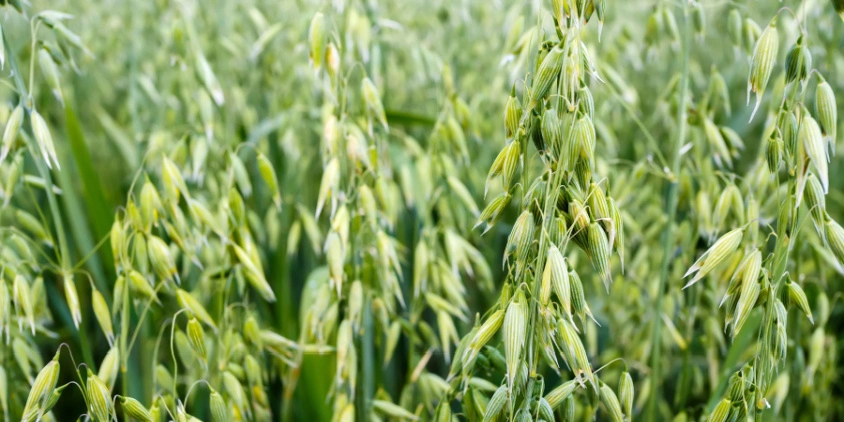
Growing Oats: Expert Tips From Planting To Harvesting
Oats are valued for much more than just the grains used in healthy cereals; they are an incredibly versatile crop for farmers. It’s common to grow oats as forage for livestock, supplying excellent nutrition when harvested as hay or silage. Additionally, it’s an ideal high-biomass cover crop to grow for protecting soil health. Though the plant may be adaptable and hardy, that doesn’t mean farmers can let their guard down when growing oats. Proper irrigation, fertilizer applications at the right times, and pest and disease management are still essential. If you want to know how to grow oats for the best yield, this article will show you the ropes.
When And Where Do Oats Grow?
Oats are an annual crop that grows best in cold climates. Although they are most commonly sown in the spring for grain harvest, planting oats in the fall for forage or cover cropping is also popular. The exact growing window depends on local weather patterns and growing conditions.
The crop grows in numerous regions across the globe, with most production occurring in the European Union, Canada, Australia, China, Brazil, and the USA. The five most important US states for oat production are North and South Dakota, Minnesota, Wisconsin, and Pennsylvania.
Optimal Growing Conditions For Oats
The plant thrives in relatively cold growing conditions and can even withstand mild frosts. Just like other grasses, it prefers growing in soils with good drainage. The crop’s specific growing requirements are further discussed in more detail.
Sunlight And Temperature To Grow Oats
Since there are numerous crop varieties, it is important to select one that has been adapted to your growing zone. Plants need at least six hours of sunshine per day, preferably in full sun, but partial sun will do as well. During the summer months, they are particularly fond of basking in the morning sun.
Although the plant prefers cooler temperatures for germination and growth, it can grow well in warmer temperatures once it’s well established. Optimal temperatures for growth of oats are 68–70°F (20–21°C). Be prepared to supply additional water as the temperature grows. While the plants are typically hardy in mild frosts, most will perish at temperatures lower than 5°F (-15°C).
Keep track of the temperature in your field and growing region using EOSDA Crop Monitoring. Reliable data from weather providers enables you to track past and present weather conditions and get a forecast for the upcoming two weeks. Moreover, the Weather risk notifications feature allows you to customize the temperature thresholds for your crop and receive timely notifications in case of extreme temperatures in your field. With our services, you can have peace of mind knowing that you’ll have ample time to address challenging conditions and mitigate any potential risks to your crop.
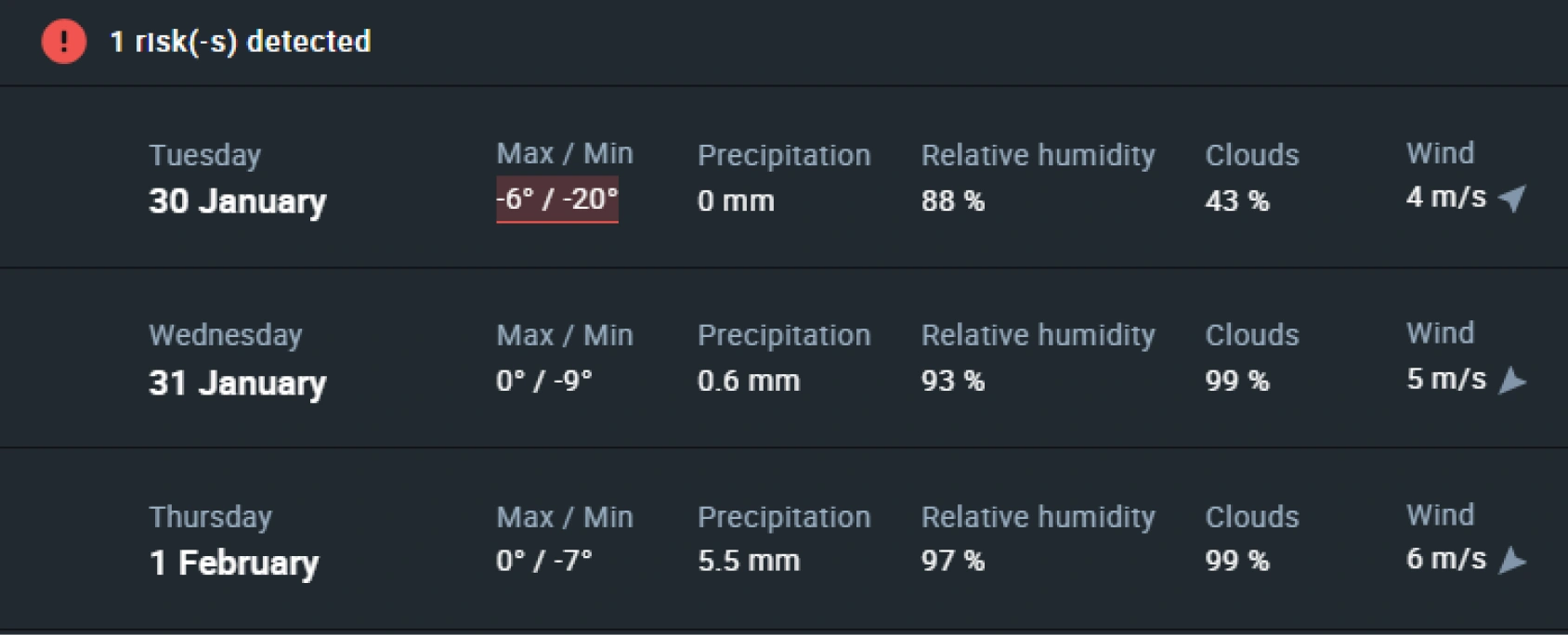
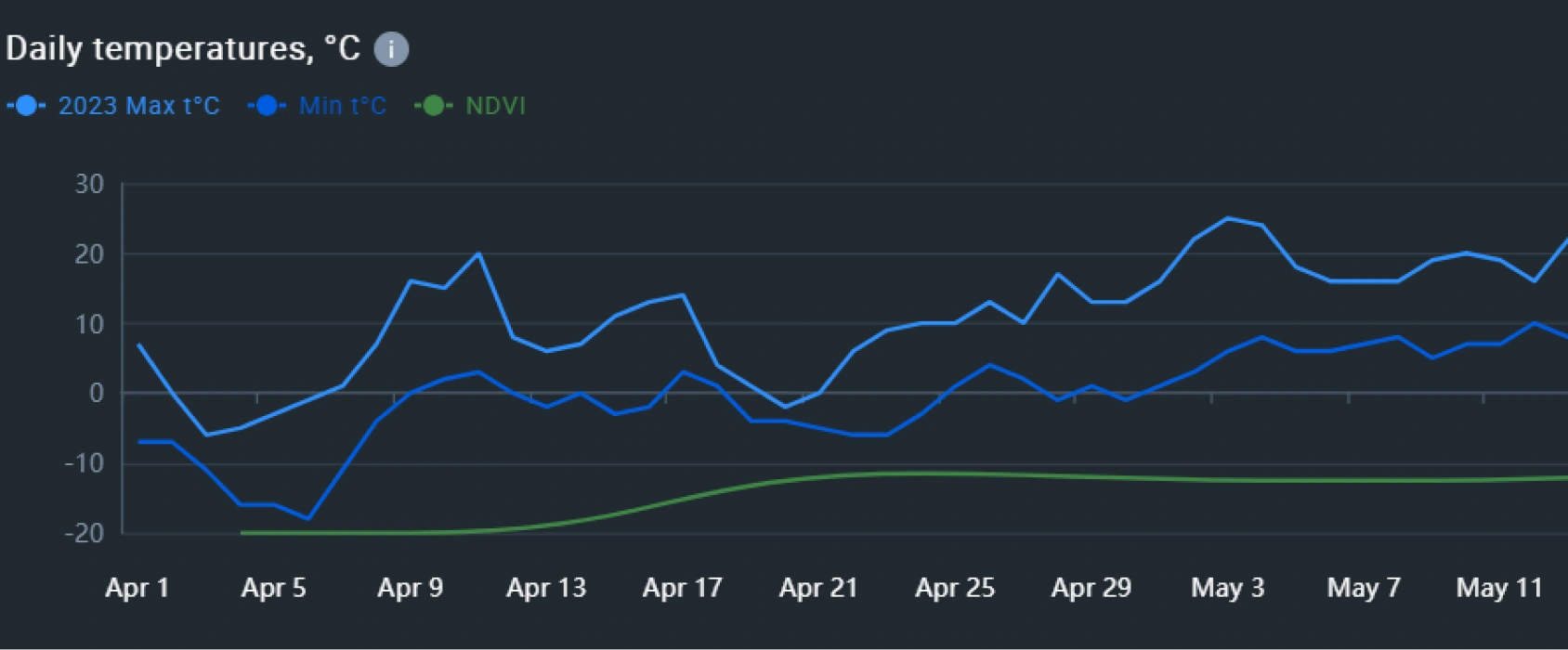
Water Requirements To Grow Oats
Oat plants are water-loving and thrive when they receive ample watering. To achieve high oat yields, you need growing conditions with high relative humidity and regular precipitation. Crop yields are almost directly proportional to the amount of rain that falls during the summer.
Inadequately moist soils hinder the establishment of seedlings. So, during dry spells, you’ll have to irrigate your fields. Morning waterings at the plant’s base will help prevent over-transpiration and shield growing plants from the midday sun’s heat.
Soil Requirements To Grow Oats
Although oats do best in soils with good drainage, they can grow in different soils. Soil pH levels between 6.0 and 7.0 are suitable for growing oats, while some cultivars can withstand pH levels of around 4.5.
Thanks to its deep and branched root system, which is good at the assimilation of nutrients, oats are less demanding in terms of soil fertility than other spring crops. Furthermore, they are capable of soil nutrient extraction from hardly soluble compounds. Because of this, they are commonly believed to be low-maintenance crops that can grow well even in poor soils, but in fact, the crops, especially dwarf varieties, perform much better in healthy and fertile soils.
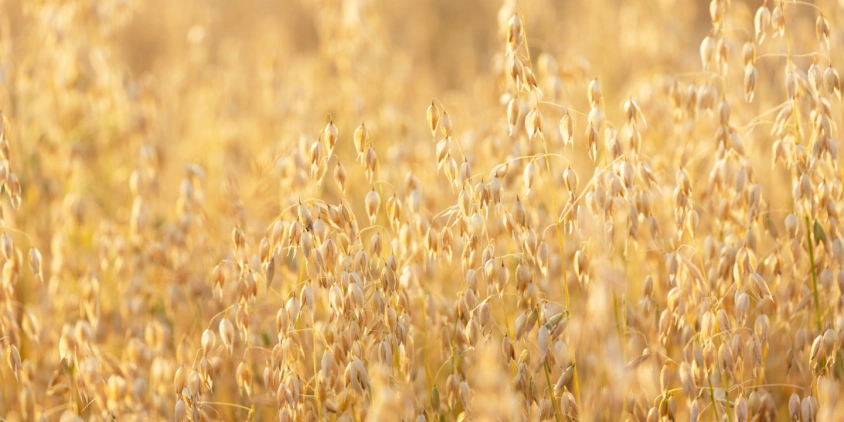
Soil Preparation And Planting Oats
Soil preparation for planting should begin well in advance of the actual start of the oats’ growing season, preferably in the fall. At this time, farmers should disc and ridge the soil to improve its structure, aerate it, accelerate its warming in the spring, and minimize the likelihood of crop damage by phytotoxins. Get the seedbed ready at least two or three weeks before sowing the seeds. When the soil is smooth and firm, seeds can germinate easier, and the seedlings can grow faster. Deep tillage may promote the robust growth of spring-sown row oat crops. Harrows and tractors are a few examples of agricultural machinery and equipment used for tilling the soil before planting.
Planting oats in the spring is a prevalent practice. Use the weather as a guide when selecting planting dates. For planting oats, the soil temperature should be at least 40°F (4°C). The optimal air temperature for planting ranges from 32 to 35°F (0 to 2°C), but plants can endure later frosts.
Oats’ planting rate of about 80 lbs/acre (90 kg/ha) and row spacing of 6 inches (15 cm) will work fine with grain drills. The ideal planting depth for oats is around 1.5 inches (4 cm). However, if you are growing them for fodder, a depth of 0.5 to 0.75 inches (1.3 to 1.9 cm) may be beneficial in terms of emergence rate and forage production .
To hasten the swelling and germination of seeds, sow them in sufficiently moist soil. Ensure that the soil is consistently moist before the seeds sprout, and keep watering regularly to promote seedling establishment.
EOSDA Crop Monitoring
Manage your fields with high-resolution satellite images for the most accurate and timely changes detection!
Growing Oats As A Cover Crop
For many decades, oats have been a common cover crop because of their ability to quickly build biomass while suppressing weeds, absorb excessive nutrients in the soil, or serve as a mulch before growing low- or zero-till crops. As a high-biomass crop, planted in the spring, they will enrich the soil with organic matter, and planted in the late summer, they will produce nitrogen-rich mulch after the plants have been winterkilled. Consistently growing them as a cover crop also boosts soil potential to capture carbon and moves farmers closer to acquiring carbon credits.
To grow oats as a cover crop in your fields, sow seeds in the prepared soil, spacing them out 3 inches (7 cm) apart, without further thinning. When growing oats alongside other crops, make sure to increase row spacing to at least 8 inches (20 cm). Either way, you will protect the soil from erosion and enhance its fertility for growing other crops.
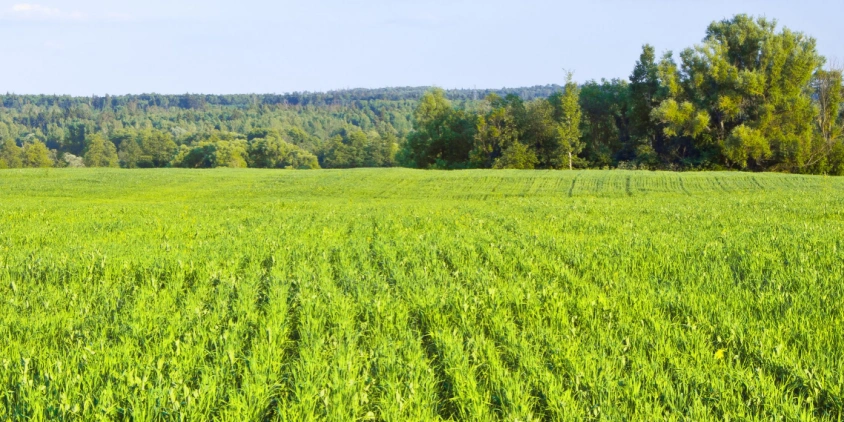
Care For Oat Crops
Growing a productive crop requires constant care, from planting through harvest. Now, we’ll go over key maintenance practices such as soil fertility management, irrigation, and disease and pest prevention.
Timely And Sufficient Fertilizing
Before planting, test the soil for nutrient deficiencies and add amendments if needed. The key nutrients needed to grow oats are the same as for other cereal crops: nitrogen (N), phosphorus (P), and potassium (K). Apply phosphorus and potassium fertilizer to your oat growing fields before soil treatment, and nitrogen fertilizer before soil cultivation. The tillering stage is the time to apply meso- and micro-nutrient fertilizers.
During the oat growing season, plant coloration is a good indicator of soil nitrogen level. Plants with a light green hue suggest that the nitrogen content of the soil is inadequate, which could lead to low-quality yield; in contrast, a dark green hue indicates that the soil contains an excess of nitrogen, making the plants more prone to lodging and falling over.
The variable rate application (VRA) supported by precision agriculture platforms allows crop producers to fertilize their oats with just the right amount of nitrogen. By referring to the Vegetation map in EOSDA Crop Monitoring, food producers can segment the field based on the vegetation status, estimate the amount of N-fertilizer each segment needs, and compute savings from VRA. Begin with 30 pounds of nitrogen per acre (33 kg/ha) in most fertile growing zones and increase the rate in less fertile zones . By tailoring your fertilizer applications to the unique needs of each growing zone, you can both save money, avoid fertilizer runoff, and prevent your crops from lodging.
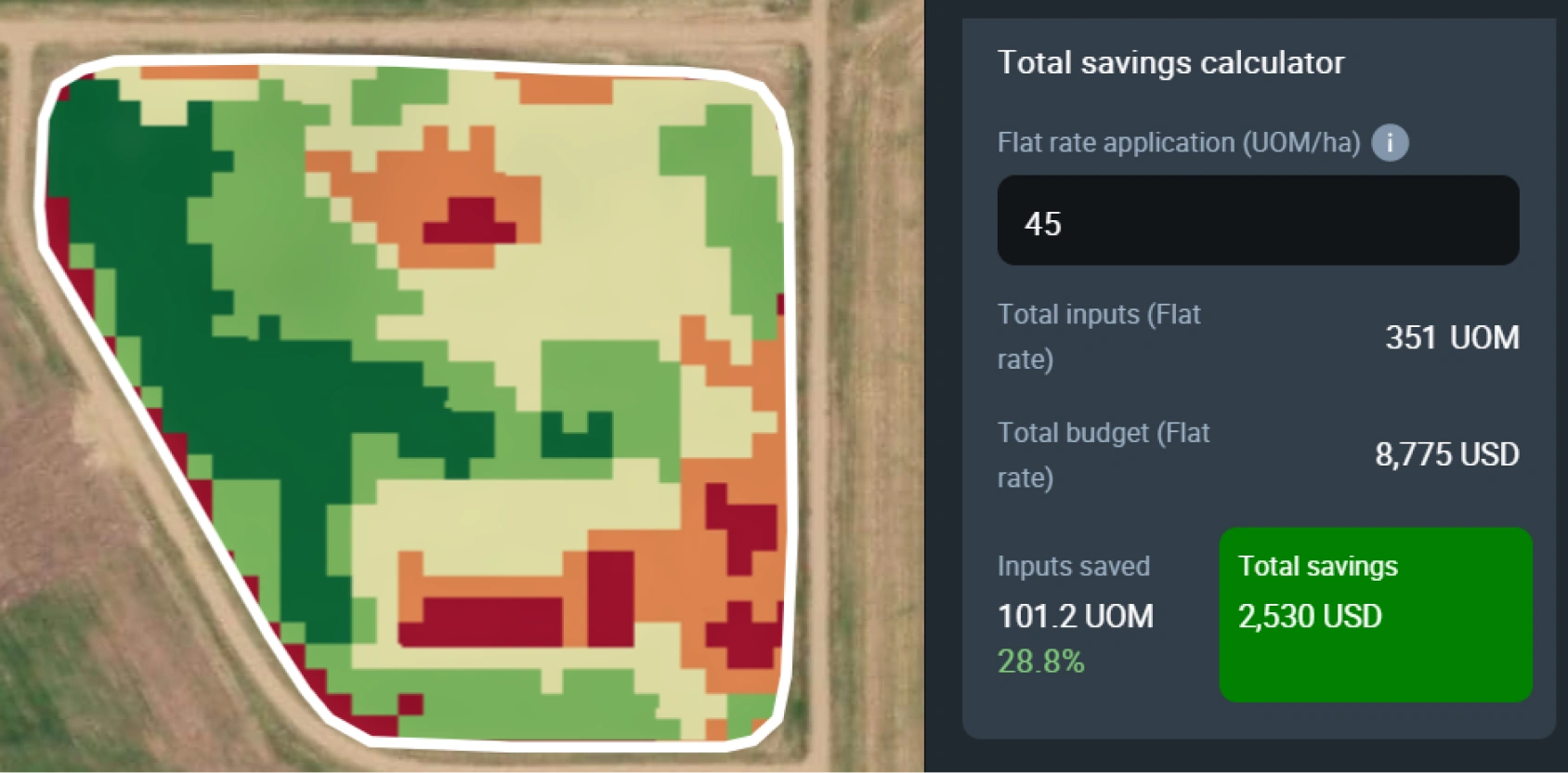
Cost-Effective Pest And Disease Control
Bugs that grow in oats can harm the crop in two ways: by eating it and by spreading viruses (like aphids transmitting barley yellow dwarf). Insect control with pesticides may not be cost-effective for oats if they are supposed to be low-input crops. Instead, farmers can use different methods of IPM (integrated pest management), primarily cultural and physical. For instance, to decrease the populations of aphids and armyworms that feed on the plant’s leaves, you can deter pests with high-pressure water spray. Reducing populations of stinkbugs and wireworms eating young plants is possible through weeding and crop rotation.
The most prevalent diseases in oats are fungi, typically growing in conditions of excessive moisture. Growing genetically resistant varieties could be the most environmentally and economically sound way to control major diseases such as crown rust and leaf rust. To further reduce the likelihood of leaf or crown rust, it is recommended to clear fields of any potential host plants. Growing oats in moderately dry areas and rotating crops may help prevent anthracnose, crown rust, septoria avenae blotch, powdery mildew, fusarium ear blight, and loose smut. To keep pests and diseases at bay, rotate crops so that oats don’t grow after oats and other grains. The Disease risk feature in EOSDA Crop Monitoring allows for the recording of oat disease occurrences in one or multiple fields simultaneously, facilitating prompt responses to potential threats.
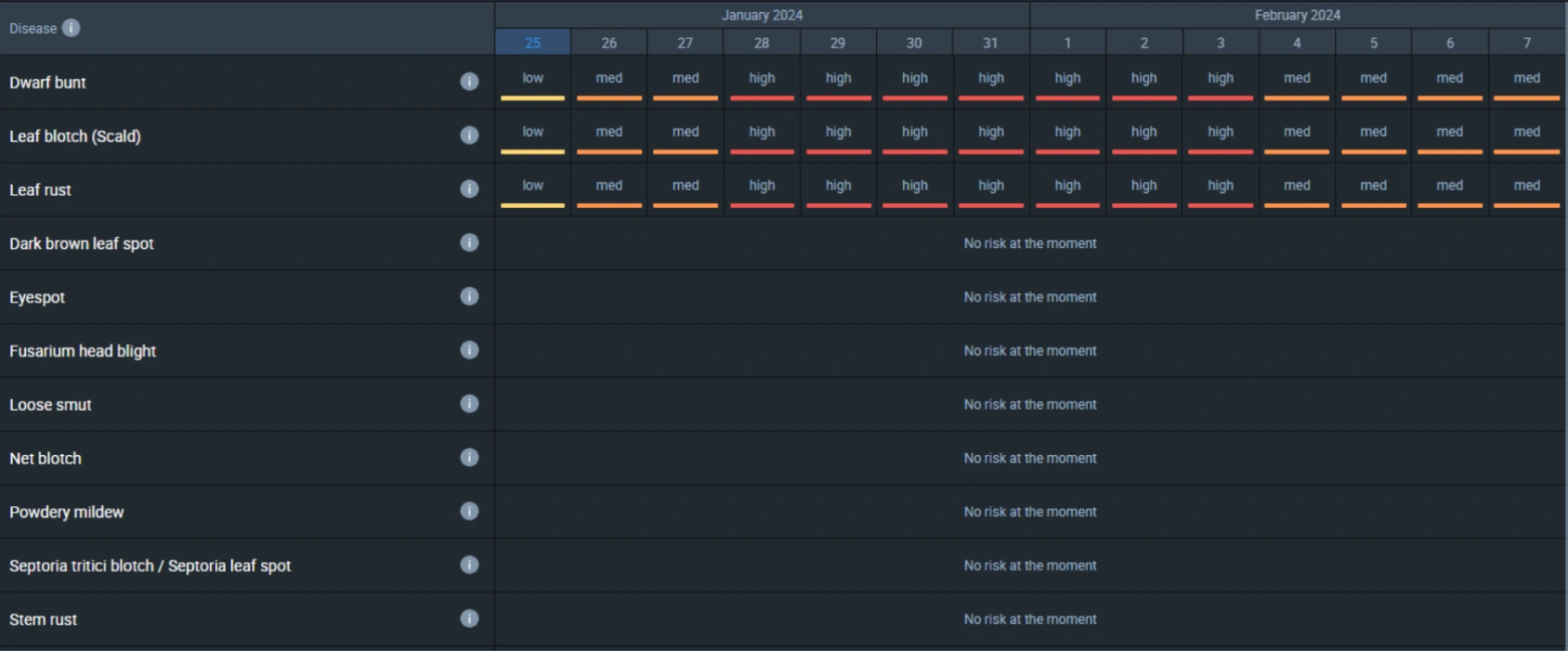
Regular Watering During Times Without Rain
Oats are typically cultivated as rain-fed crops, but if there isn’t enough rain, you’ll need to irrigate them. If soil moisture levels fall below 70–75%, it’s necessary to water. When deciding how often to water, consider factors like the amount of precipitation, the soil’s ability to retain water, and the rate of evapotranspiration. In hot and dry growing conditions, water your plants every three days.
Growing oats, a water-loving plant, requires more frequent watering and higher soil moisture levels than growing barley. About 1 inch (25 mm) per week is how much water is needed to grow oats. The most crucial times to water your growing plants are when they are tillering, booting, and starting to fill with grain.
During the process of growing oats, it’s important not to overlook the moment when soil moisture and weather conditions dictate more irrigation. Our agriculture platform may help you with this. Using EOSDA Crop Monitoring, pay close attention to the fields’ moisture levels and the weather forecasts over the next two weeks. In times of low soil moisture or impending dry weather, watering your growing plants more often will ensure that they reach their maximum potential.
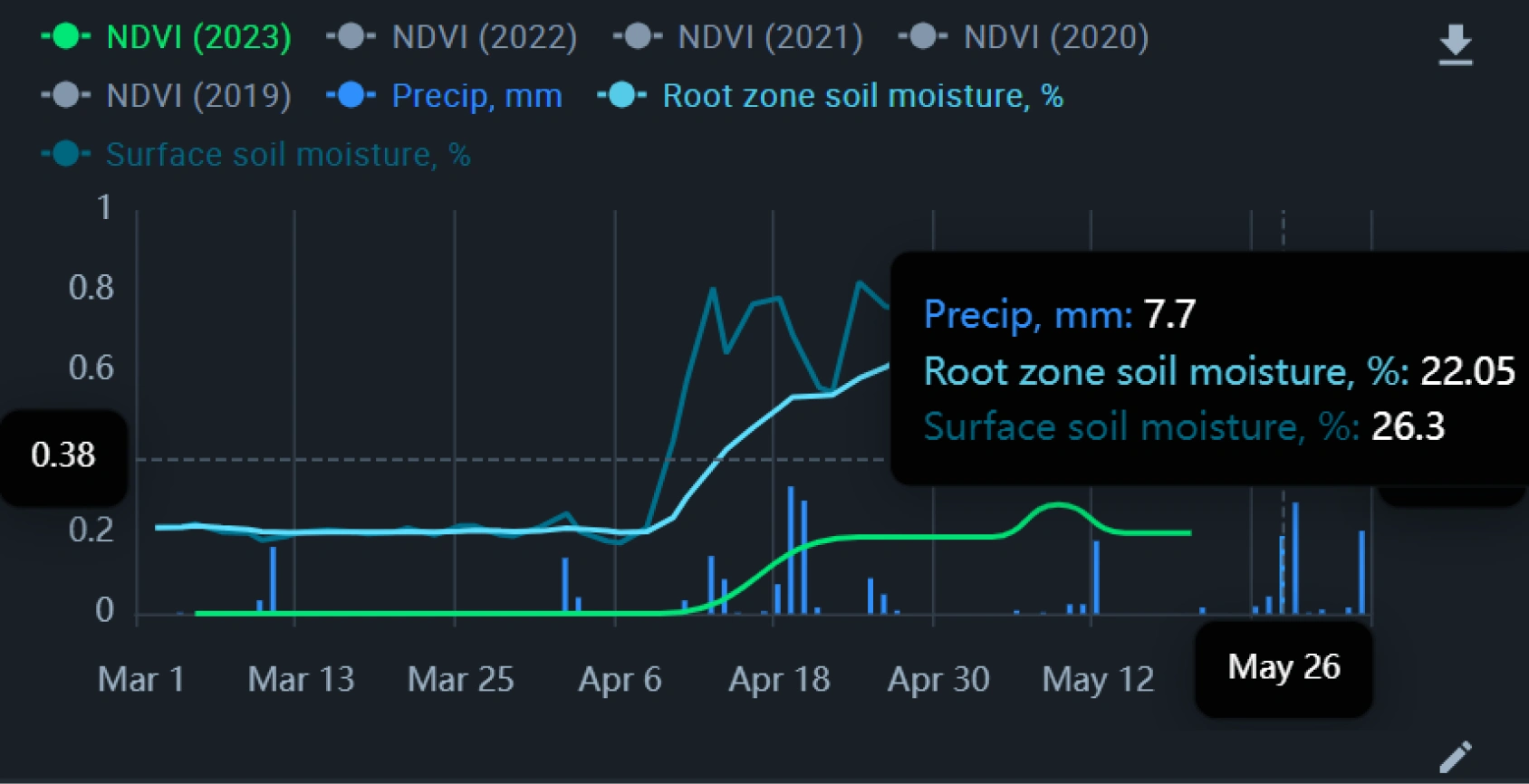
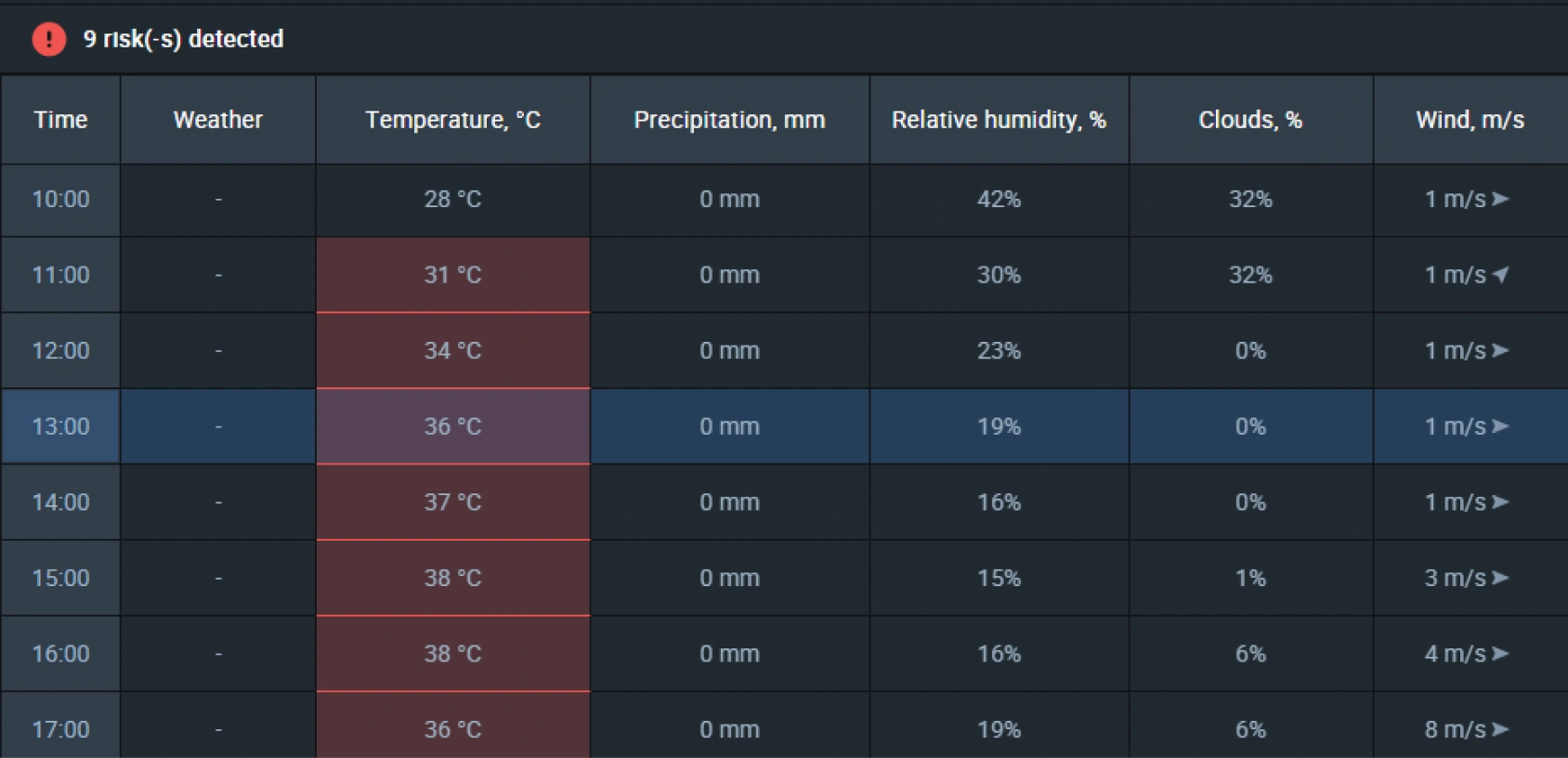
How Long Does It Take For Oats To Grow?
The growth time for oats can be anywhere from 80 to 110 days, depending on the growing conditions and crop variety. Factors like an abundance or scarcity of nutrients and moisture can lengthen or reduce the time it takes for the plant to reach any given growth stage. Additional variables that could affect how long it takes for plants to grow include plant density, disease and pest infestations, and weed pressure.
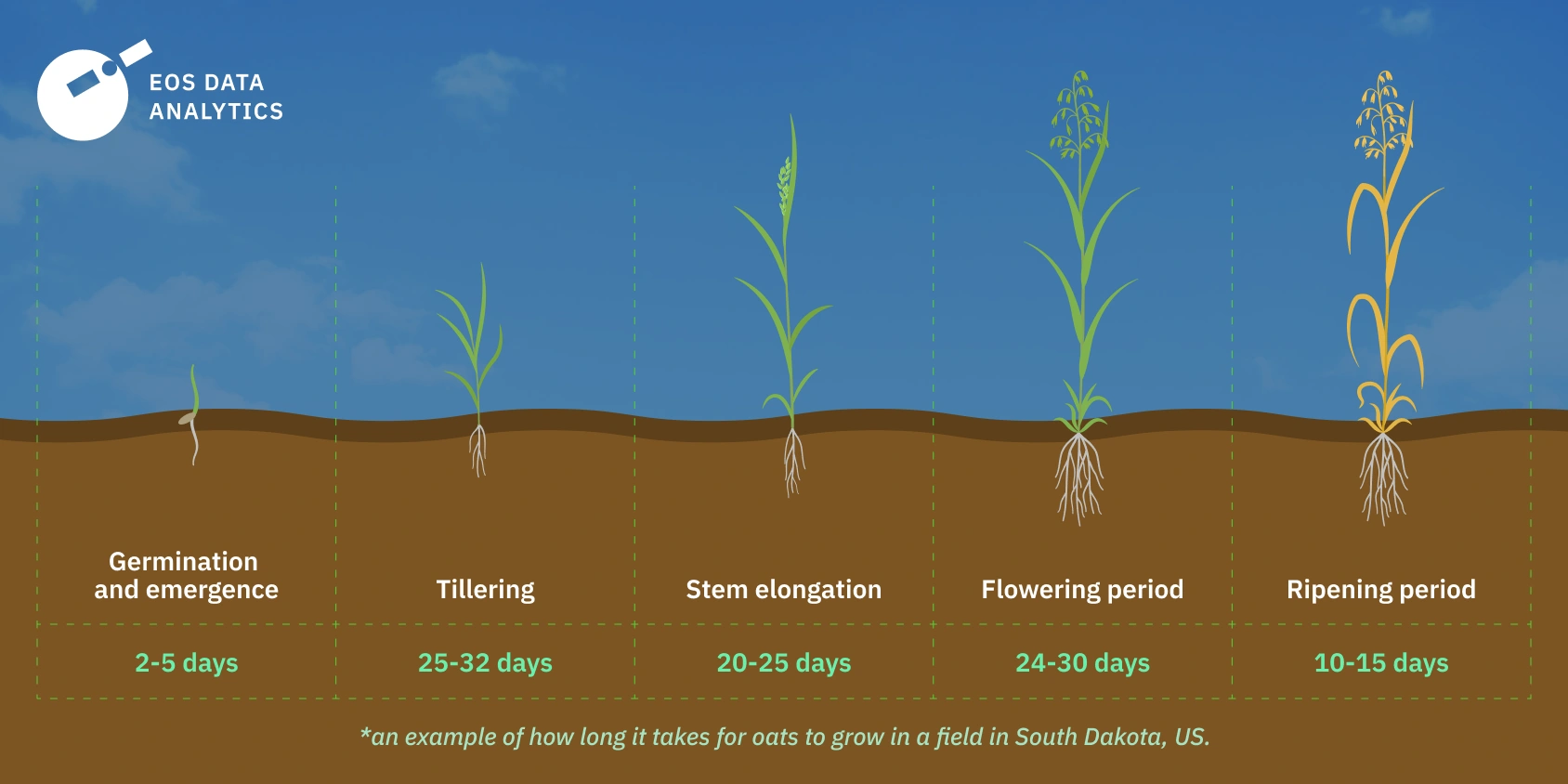
Harvesting Oats
It is common to harvest oats about twelve weeks after planting, in the middle of summer or later. You’ll know it’s time to harvest oats when the field becomes uniformly yellow. Kernels ready for harvesting and storage are hard and dry (12–12.5% moisture content). Opt for dry weather to harvest the crop; ideally, wait at least 24 to 48 hours after the last rain.
It is best to harvest the crop for grain by direct heading when it is fully ripe, although swathing it earlier is an option if the crop isn’t evenly ripe or the weather won’t allow the grain to naturally dry fast. Direct heading, which minimizes seed shattering, is the most practical oats harvest method, provided that the grain moisture content is uniform. When harvesting the crop, large-scale farmers use combine harvesters to separate the grain from the stem promptly.
Post-harvest stubble will make a good snow trap and protect the soil from winter frosts. As a part of crop residue management, you may chop the stalks that are left over after harvesting and distribute them all across the field as mulch to improve the soil.
About the author:
Vasyl Cherlinka is a Doctor of Biosciences specializing in pedology (soil science), with 30 years of experience in the field. He attended the engineering college in Ukraine and received his degree in agrochemistry, agronomy and soil science in the Chernivtsi National University. Since 2018, Dr. Cherlinka has been advising EOSDA on problems in soil science, agronomy, and agrochemistry.
Recent articles

Analyze 2025 & Plan Your Best Year Yet: LandViewer Christmas Offer
It’s the most wonderful time of the year! The Christmas holidays are here, and so is your chance to analyze 2025 and plan a prosperous 2026 with more affordable Pro plans in LandViewer.

EOSDA Models Climate Change Impact On Sugarcane Yields
EOSDA modeled future temperature, rainfall, and other climate impacts on Veracruz sugarcane. The results help growers plan long-term adaptation strategies, including timing, varieties, and irrigation.

EOSDA LandViewer Black Friday Sale: Exclusive Offers & Giveaway
This Black Friday, LandViewer offers new users the chance to save on monthly plans, get extra months with yearly subscriptions, and participate in a free annual plan giveaway.